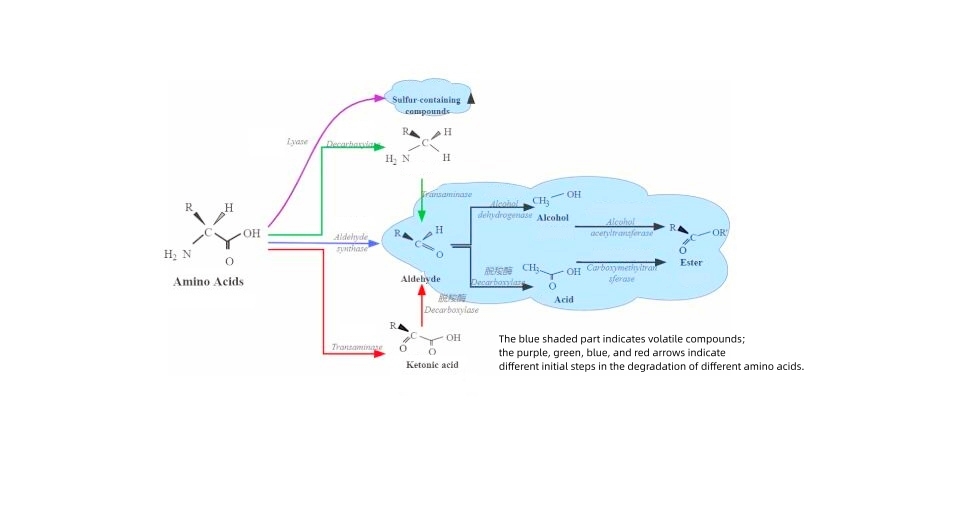Researchers conducted a field test using G-Teck Free Amino Acids to study the effect of free amino acids on the flavor quality of plant-based foods. They focused on the factors affecting the taste of amino acids, including the taste threshold of amino acids and the synergistic/inhibitory effects between taste components.
Field trial main measures: fertilization, bagging, grafting and other pre-harvest measures. and final conclusion descripted as following:
Since certain free amino acids are present in plants in low concentrations, below the taste threshold concentration, they are not considered to contribute to the taste of food. Therefore, increasing the content of sweet and savory amino acids in plants can improve the flavor quality of crops through preharvest nutrient management and field measures.
Free amino acids can undergo transamination, dehydrogenation, decarboxylation, reduction, and other reactions to produce acids, alcohols, aldehydes, esters, as well as N- and S-containing flavor substances.
| Amino acid taste threshold (g/L) | |||||
| Aminoacid | Threshold | Taste | Aminoacid | Threshold | Taste |
| D-Ser | 6.8 | Sweet | L-Ser | 2.19 | Sweet |
| D-Thr | 4.01 | L-Pro | 1.74 | ||
| D-Gly | 2.32 | L-Thr | 3.06 | ||
| D-Ile | 1.64 | L-Gly | 2.32 | ||
| D-Asn | 1.29 | L-Ala | 1.44 | ||
| D-Ala | 1 | L-Phe | 1.09 | Bitter | |
| D-Met | 0.75 | L-Ile | 0.97 | ||
| D-Leu | 0.66 | L-Leu | 0.84 | ||
| D-Gln | 0.51 | L-Met | 0.55 | ||
| D-Val | 0.35 | L-Val | 0.49 | ||
| D-His | 0.29 | L-Trp | 0.47 | ||
| D-Trp | 0.1 | L-His | 0.19 | ||
| D-Cys | 0.01 | L-Arg(HCl) | 0.21 | ||
| D-Phe | 0.26 | L-Lys(HCl) | 0.07 | ||
| D-Lys(HCl) | 0.19 | L-Cys | 0.01 | ||
| D-Pro | 6.95 | Bitter | L-Gln | 1.43 | Sour/Sweet |
| D-Arg(HCl) | 0.28 | L-Asn | 0.21 | ||
| D-Asp | 0.1 | Sour | L-Asp | 0.02 | Sour/Umami/Salty |
| D-Glu | 0.01 | L-Glu | 0.01 | ||
L-theanine, formed from L-glutamic acid and ethylamine, is the main contributor to the mellow flavor of tea. During tea processing, L-Phe, L-Lys, and L-Arg react with polyphenols and soluble sugars to generate aldehydes, acids, and alcohols, which enhance the aroma of tea. As precursor compounds, L-Pro, L-Glu, L-Arg, L-Asn, L-Cys and GABA made important contributions to the formation of wine sensory quality.
Derivatives (E) of aromatic amino acids (L-Phe, L-Tyr, L-Trp) – cinnamaldehyde, methyl salicylate, methyl benzoate, and vanillin have cinnamon and floral aromas; composed of L-Phe the 2-phenylethyl alcohol and 2-phenyl ethyl acetate produced by decomposition strongly affect the floral aroma of wine.
Branched-chain amino acids (L-Leu, L-Ile, L-Val) can be converted into malty-flavored aldehydes, fruity-flavored and alcoholic-flavored alcohols, and sour, fruity and buttery-flavored acids; L-Thr conversion Acetaldehyde contributes to the special flavor of yogurt.
Post time: Sep-08-2023





